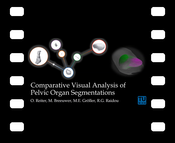Information
- Publication Type: Journal Paper with Conference Talk
- Workgroup(s)/Project(s):
- Date: 2018
- Journal: Computer Graphics Forum
- Event: EuroVis 2018
- DOI: 10.2312/eurovisshort.20181075
- Call for Papers: Call for Paper
- Pages: 037-041
- Conference date: June 2018
Abstract
In prostate cancer treatment, automatic segmentations of the pelvic organs are often used as input to radiotherapy planning systems. However, natural anatomical variability of the involved organs is a common reason, for which segmentation algorithms fail, introducing errors in the radiotherapy treatment procedure, as well. Understanding how the shape and size of these organs affect the accuracy of segmentation is of major importance for developers of segmentation algorithms. However, current means of exploration and analysis provide limited insight. In this work, we discuss the design and implementation of a web-based framework, which enables easy exploration and detailed analysis of shape variability, and allows the intended users - i.e., segmentation experts - to generate hypotheses in relation to the performance of the involved algorithms. Our proposed approach was tested with segmentation meshes from a small cohort of 17 patients. Each mesh consists of four pelvic organs and two organ interfaces, which are labeled and have per-triangle correspondences. A usage scenario and an initial informal evaluation with a segmentation expert demonstrate that our framework allows the developers of the algorithms to quickly identify inaccurately segmented organs and to deliberate about the relation of variability to anatomical features and segmentation quality.Additional Files and Images
Weblinks
BibTeX
@article{EuroVis2018-ShortPapers-Reiter,
title = "Comparative Visual Analysis of Pelvic Organ Segmentations",
author = "Oliver Reiter and Marcel Breeuwer and Eduard Gr\"{o}ller and
Renata Raidou",
year = "2018",
abstract = "In prostate cancer treatment, automatic segmentations of the
pelvic organs are often used as input to radiotherapy
planning systems. However, natural anatomical variability of
the involved organs is a common reason, for which
segmentation algorithms fail, introducing errors in the
radiotherapy treatment procedure, as well. Understanding how
the shape and size of these organs affect the accuracy of
segmentation is of major importance for developers of
segmentation algorithms. However, current means of
exploration and analysis provide limited insight. In this
work, we discuss the design and implementation of a
web-based framework, which enables easy exploration and
detailed analysis of shape variability, and allows the
intended users - i.e., segmentation experts - to generate
hypotheses in relation to the performance of the involved
algorithms. Our proposed approach was tested with
segmentation meshes from a small cohort of 17 patients. Each
mesh consists of four pelvic organs and two organ
interfaces, which are labeled and have per-triangle
correspondences. A usage scenario and an initial informal
evaluation with a segmentation expert demonstrate that our
framework allows the developers of the algorithms to quickly
identify inaccurately segmented organs and to deliberate
about the relation of variability to anatomical features and
segmentation quality.",
journal = "Computer Graphics Forum",
doi = "10.2312/eurovisshort.20181075",
pages = "037-041",
URL = "https://www.cg.tuwien.ac.at/research/publications/2018/EuroVis2018-ShortPapers-Reiter/",
}

 Honorable Mention
Honorable Mention  paper
paper Video
Video

